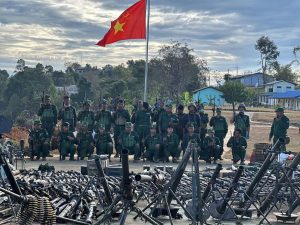In October 2023, three ethnic-based armed opposition groups launched Operation 1027, a joint military campaign against the Myanmar junta. Since then, a large swathe of junta-held territory has fallen into the hands of the opposition forces. The fallen territories include important border crossings, several towns and major population centers, and even military bases.
If the current trend on the battlefield continues, barring external diplomatic or military intervention the junta will likely collapse in front of a gun barrel.
Myanmar’s military faces issues in terms of both quantity and quality. A recent study by the United States Institute of Peace suggested that the junta military personnel numbered around 150,000, with 70,000 of them being combat soldiers. This is a far cry from the conventional estimate of about 356,000 troops.
Traditionally, a troop-to-population ratio of 20 to 1,000 is seen as necessary for an effective counterinsurgency campaign. With Myanmar’s population at more than 53 million, the junta would need more than 1 million personnel on its payroll to meet that threshold. Another study suggests a lower troop-to-population ratio of 2.8 to 1,000 for successful counterinsurgency campaigns. In this case, the junta would have to deploy nearly 150,000 troops to succeed. It’s questionable whether they have that many troops at their disposal.
The numbers game is critical for any regime to survive an insurgency campaign. A sufficient number of troops is necessary to capture the insurgents’ territory, hold onto the ground, and provide security for rebuilding efforts. The junta’s 70,000 combat troops are insufficient to deal with the ongoing insurgency, much less to organize an effective and coordinated counteroffensive to recapture lost territories.
The poor quality of military personnel is another critical factor that adversely impacts the junta’s ability to repel the opposition groups’ advances. There are reports of personnel from different units being cobbled together to form a fighting force or inexperienced officers sent to defend the junta’s bases. To bolster its numbers, the military has used coercion to recruit new personnel, who are poorly trained and even less motivated to fight for the junta. These examples demonstrate the junta’s desperation to recruit sufficient numbers of troops.
Meanwhile, the existing forces are suffering from diminishing morale, as demonstrated by several incidents when junta troops surrendered or fled to neighboring states instead of defending their positions. In one major mass surrender, more than 300 junta troops and their families decided to lay down their arms and surrendered to the Arakan Army in Rakhine State. There are also conflicting reports that the junta had sentenced several generals who surrendered to the opposition groups in Shan State to death or life imprisonment. This incident will likely further impact morale among military personnel.
Beyond the numbers game, Myanmar’s military has heavily relied on air power and support to check the opposition groups’ advances. Yet the junta’s dominance in the air is being challenged. There have been cases of opposition forces successfully shooting down the junta’s aircraft. Furthermore, opposition forces have also shown their ability to use air power against the junta’s forces, successfully employing drones targeting the junta’s bases.
Defeats on the battlefield are leading to internal division within the junta. A leading pro-junta monk recently called for a change in the military leadership. Other junta supporters have also called for junta leader Min Aung Hlaing to step down because of the military’s poor performance. Given the current grave situation at the frontline, the internal division is another distraction that the junta cannot afford. More battlefield defeats will likely increase the calls for the junta leadership to back down, adding further pressure to the junta’s brittle hold on power.
Finally, the junta is being slowly cut off from the outside world. The opposition forces have captured areas bordering China and India, and are battling junta forces to capture Loikaw, a key town near the Thai border. Rebel forces have also conducted attacks on Danyawaddy Naval Base, near a joint special economic zone being developed with China.
Suppose the current trend in the battlefields – losing posts and military bases in the countryside – continues. In that case, the junta forces will likely be pushed toward major population centres such as Naypyidaw and Yangon. Military troops will be isolated from one another as the opposition forces tighten their grips through the rural areas, cutting off roads and communication between junta-held areas.
The junta will likely rely on its air force to repel any advances by the opposition groups, but air power alone is insufficient in any insurgency campaign. Consider, for example, the United States’ air campaign during the Vietnam War. The Americans dropped over 5 million tons of bombs throughout the conflict but still lost the war in 1975.
In the absence of intervention by external powers, the junta will be hard-pressed to survive as opposition forces in Myanmar continue to press their advantage. What happens next is anyone’s guess.

































